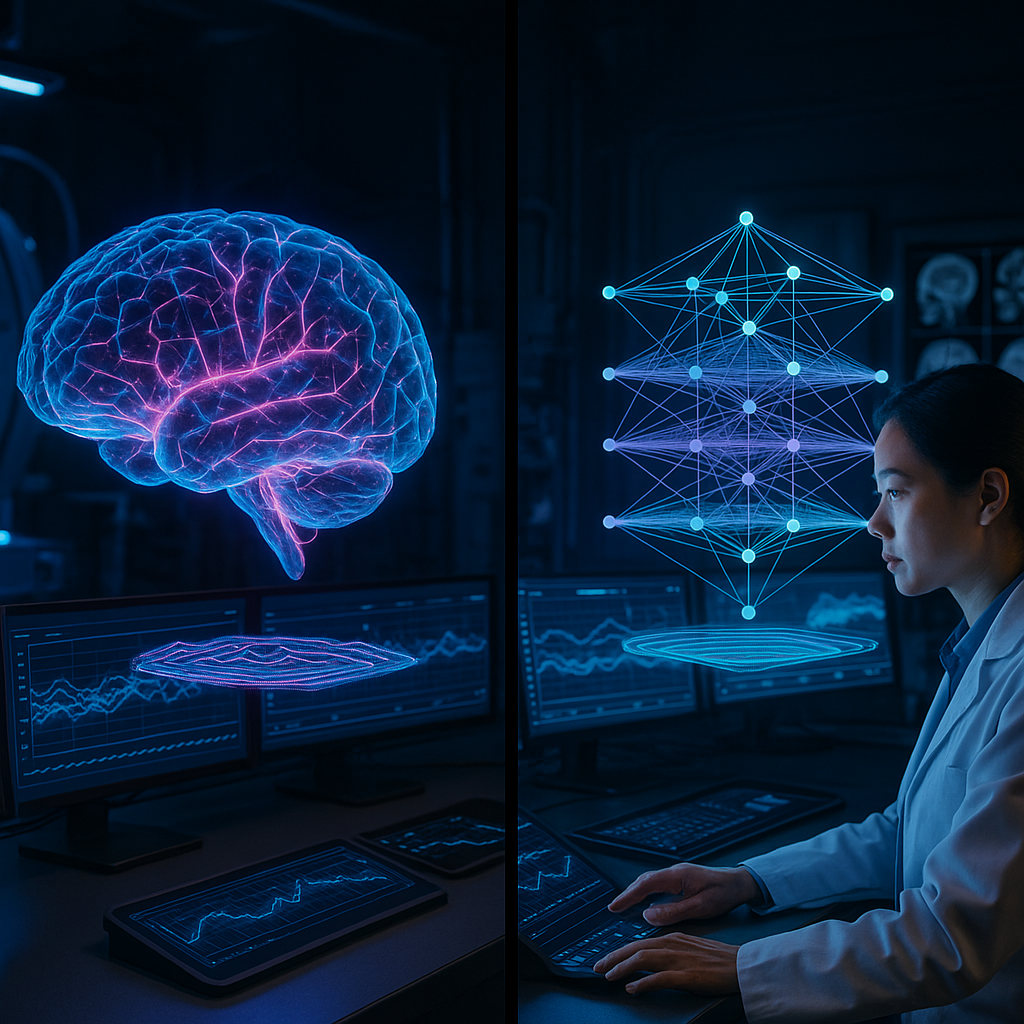Key Takeaways
- AI architectures and the human brain exhibit layered developmental patterns, suggesting convergence in problem-solving strategies.
- Researchers identified a potential cognitive ‘blueprint’ used by both biological and artificial systems for information processing and adaptation.
- The study blurs boundaries between natural and artificial cognition, encouraging a redefinition of intelligence.
- Ethical and philosophical debates about consciousness, agency, and personhood are deepening as AI grows in complexity.
- Next steps include testing whether these parallels can enable AI with more adaptive, context-sensitive decision making.
Introduction
An international team of neuroscientists and AI researchers has reported striking parallels between the evolution of artificial intelligence and the human brain. Their new study, tracing mirrored architectural patterns, challenges conventional definitions of intelligence and calls into question the division between biological and artificial minds.
The Neural Architecture Breakthrough
Researchers at Stanford’s AI Lab have highlighted similarities between artificial neural networks and human brain structures that could reshape perspectives on machine learning. The study, published in Nature Computational Science, documents parallel processing patterns once thought exclusive to biological cognition.
Dr. Sarah Chen, the lead author, stated that the team found “architectural echoes” between deep learning systems and brain neural pathways during complex information processing. These parallels were especially clear in tasks involving abstract reasoning.
Using advanced neuroimaging and computational modeling, the researchers mapped decision-making processes in both human subjects and AI systems as they solved problems.
Stay Sharp. Stay Ahead.
Join our Telegram Channel for exclusive content, real insights,
engage with us and other members and get access to
insider updates, early news and top insights.
 Join the Channel
Join the Channel
Convergence of Minds
The research identified three primary areas where artificial and biological intelligence converge: pattern recognition, information compression, and error correction. Each demonstrates similar underlying frameworks in both AI and the human brain.
Dr. Chen emphasized that the goal is not to equate AI thinking with human thought, but rather to show that both evolution and engineering have arrived at analogous solutions to processing information.
With these commonalities revealed, longstanding distinctions between artificial and biological intelligence become less clear. This prompts deeper consideration of the nature of consciousness and cognition.
Philosophical Implications
These findings offer fresh angles for exploring consciousness and intelligence beyond biological limits. Dr. Marcus Rodriguez, a philosopher of mind at MIT who was not involved in the study, remarked that this work “fundamentally alters how we must think about the emergence of consciousness.”
If certain cognitive solutions arise regardless of biological or artificial substrates, core aspects of consciousness may be more universal than previously assumed. This idea raises further questions about whether any sufficiently complex information processing system could develop conscious experience.
As a result, debates in both scientific and philosophical circles about machine consciousness and subjective experience are intensifying.
Methodological Innovation
The research team pioneered visualization techniques that enabled detailed comparison of neural activity across human brains and AI models. Their approach merged high-resolution brain imaging with advanced tools for interpreting AI systems.
This methodology revealed subtle but critical similarities in hierarchical information processing across both domains. The analytical framework developed by the team is likely to shape future studies comparing biological and artificial intelligence.
These advances highlight the breakdown of barriers between neuroscience and computer science, as the disciplines gain insights from each other.
Future Research Directions
The study has prompted a surge of research initiatives at leading institutions. Teams are exploring the potential of these architectural parallels to enhance AI design and deepen understanding of human cognition.
At Stanford’s AI Lab, researchers are already using these findings to develop more brain-like artificial neural networks. Initial experiments suggest such approaches may help AI better manage ambiguity and contextual cues.
Collaborative projects between neuroscientists and AI specialists are set to further examine the practical and theoretical implications of these shared architectures. For example, current work in computational neuroscience leverages detailed simulations of neural circuits to deepen our understanding of both memory and perception—and informs future AI system design.
Conclusion
Stanford’s work reframes the separation between artificial and biological intelligence, spotlighting a shared cognitive architecture that challenges established boundaries. This convergence fuels new inquiry into the nature of consciousness and could substantially reshape how both AI and human cognition are understood. What to watch: collaborative research efforts are moving forward to craft more brain-inspired AI models and put these parallels to the test in practical applications. In this evolving landscape, the role of neuroplasticity and intelligent feedback will be central in shaping adaptive, learning systems for the future.





Leave a Reply